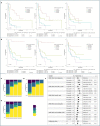uPAR+ extracellular vesicles: a robust biomarker of resistance to checkpoint inhibitor immunotherapy in metastatic melanoma patients
- PMID: 33972390
- PMCID: PMC8112420
- DOI: 10.1136/jitc-2021-002372
uPAR+ extracellular vesicles: a robust biomarker of resistance to checkpoint inhibitor immunotherapy in metastatic melanoma patients
Abstract
Background: Emerging evidence has highlighted the importance of extracellular vesicle (EV)-based biomarkers of resistance to immunotherapy with checkpoint inhibitors in metastatic melanoma. Considering the tumor-promoting implications of urokinase-type plasminogen activator receptor (uPAR) signaling, this study aimed to assess uPAR expression in the plasma-derived EVs of patients with metastatic melanoma to determine its potential correlation with clinical outcomes.
Methods: Blood samples from 71 patients with metastatic melanoma were collected before initiating immunotherapy. Tumor-derived and immune cell-derived EVs were isolated and analyzed to assess the relative percentage of uPAR+ EVs. The associations between uPAR and clinical outcomes, sex, BRAF status, baseline lactate dehydrogenase levels and number of metastatic sites were assessed.
Results: Responders had a significantly lower percentage of tumor-derived, dendritic cell (DC)-derived and CD8+ T cell-derived uPAR +EVs at baseline than non-responders. The Kaplan-Meier survival curves for the uPAR+EV quartiles indicated that higher levels of melanoma-derived uPAR+ EVs were strongly correlated with poorer progression-free survival (p<0.0001) and overall survival (p<0.0001). We also found a statistically significant correlation between lower levels of uPAR+ EVs from both CD8+ T cells and DCs and better survival.
Conclusions: Our results indicate that higher levels of tumor-derived, DC-derived and CD8+ T cell-derived uPAR+ EVs in non-responders may represent a new biomarker of innate resistance to immunotherapy with checkpoint inhibitors. Moreover, uPAR+ EVs represent a new potential target for future therapeutic approaches.
Keywords: Biomarkers; CD8-Positive T-Lymphocytes; Dendritic Cells; Immunotherapy; Melanoma; Tumor.
© Author(s) (or their employer(s)) 2021. Re-use permitted under CC BY-NC. No commercial re-use. See rights and permissions. Published by BMJ.
Conflict of interest statement
Competing interests: None declared.
Figures




Similar articles
-
Circulating extracellular vesicles expressing PD1 and PD-L1 predict response and mediate resistance to checkpoint inhibitors immunotherapy in metastatic melanoma.Mol Cancer. 2022 Jan 18;21(1):20. doi: 10.1186/s12943-021-01490-9. Mol Cancer. 2022. PMID: 35042524 Free PMC article.
-
Dynamic Change of PD-L2 on Circulating Plasma Extracellular Vesicles as a Predictor of Treatment Response in Melanoma Patients Receiving Anti-PD-1 Therapy.J Extracell Vesicles. 2025 Apr;14(4):e70054. doi: 10.1002/jev2.70054. J Extracell Vesicles. 2025. PMID: 40135876 Free PMC article.
-
Tumor CD155 Expression Is Associated with Resistance to Anti-PD1 Immunotherapy in Metastatic Melanoma.Clin Cancer Res. 2020 Jul 15;26(14):3671-3681. doi: 10.1158/1078-0432.CCR-19-3925. Epub 2020 Apr 28. Clin Cancer Res. 2020. PMID: 32345648
-
Integrated genomic analysis identifies a genetic mutation model predicting response to immune checkpoint inhibitors in melanoma.Cancer Med. 2020 Nov;9(22):8498-8518. doi: 10.1002/cam4.3481. Epub 2020 Sep 24. Cancer Med. 2020. PMID: 32969604 Free PMC article.
-
Extracellular vesicles at the crossroad between cancer progression and immunotherapy: focus on dendritic cells.J Transl Med. 2024 Jul 29;22(1):691. doi: 10.1186/s12967-024-05457-4. J Transl Med. 2024. PMID: 39075551 Free PMC article. Review.
Cited by
-
Immunomodulatory effects of immune cell-derived extracellular vesicles in melanoma.Front Immunol. 2024 Sep 26;15:1442573. doi: 10.3389/fimmu.2024.1442573. eCollection 2024. Front Immunol. 2024. PMID: 39391320 Free PMC article. Review.
-
Emerging role of tumor-derived extracellular vesicles in T cell suppression and dysfunction in the tumor microenvironment.J Immunother Cancer. 2021 Oct;9(10):e003217. doi: 10.1136/jitc-2021-003217. J Immunother Cancer. 2021. PMID: 34642246 Free PMC article. Review.
-
Extracellular Vesicles in Cancer Drug Resistance: Roles, Mechanisms, and Implications.Adv Sci (Weinh). 2022 Dec;9(34):e2201609. doi: 10.1002/advs.202201609. Epub 2022 Oct 17. Adv Sci (Weinh). 2022. PMID: 36253096 Free PMC article. Review.
-
Extracellular Vesicles in Cancer Drug Resistance: Implications on Melanoma Therapy.Cancers (Basel). 2023 Feb 8;15(4):1074. doi: 10.3390/cancers15041074. Cancers (Basel). 2023. PMID: 36831417 Free PMC article. Review.
-
Circulating extracellular vesicles are monitoring biomarkers of anti-PD1 response and enhancer of tumor progression and immunosuppression in metastatic melanoma.J Exp Clin Cancer Res. 2023 Sep 28;42(1):251. doi: 10.1186/s13046-023-02808-9. J Exp Clin Cancer Res. 2023. PMID: 37759291 Free PMC article.
References
-
- Anon . Abstracts. Pigment Cell Melanoma Res 2020;33:148–255. 10.1111/pcmr.12834 - DOI
Publication types
MeSH terms
Substances
LinkOut - more resources
Full Text Sources
Other Literature Sources
Medical
Research Materials
